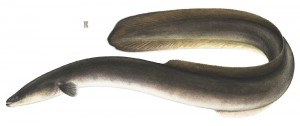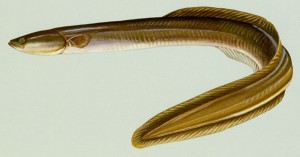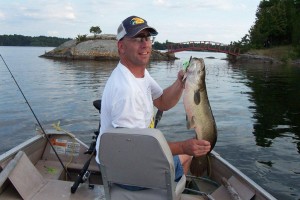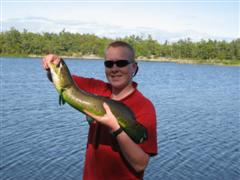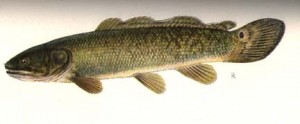June 25, 2013
Too Much of a Good Thing?
Help us Track Algae Blooms and Excessive Aquatic Vegetation
RIDEAU WATERSHED, June 25, 2013 — What is that green slime in front of your dock? Are you noticing algae blooms and an increased growth of aquatic plants on your waterbody? The Rideau Valley Conservation Authority (RVCA) wants to hear about it!
The RVCA has created a survey for lake and river users that asks questions about algae and aquatic plants on their waterbody. This survey is being conducted in response to an increasing number of concerns about algae and aquatic plants in recent years.
“We’ve been hearing that there are a lot more blooms and plants out there, but it doesn’t necessarily match what we are seeing and learning through our water quality sampling,” says Mike Yee, RVCA Manager of Biology and Water Quality.
Algae and aquatic plants play an important ecological role in lakes and rivers and they should be present in your water body. They are the first, vital links in a natural food chain that all other water creatures rely on including insects, frogs, minnows, small fish right up to top predators like bass, muskie and lake trout. Under normal circumstances, they also produce large amounts of oxygen helping to keep the water quality in a healthy state. So they are very important.
But too much of a good thing can be very bad! During warm weather, populations of algae and aquatic vegetation can grow quickly to form large masses. As the mass grows and expands, algae and plants at the lower levels die off and decompose over large areas. This process uses up much of the oxygen in the water and degrades the entire aquatic ecosystem.
“If you’ve noticed changes — or not — we want to hear from you,” says Yee. “We want to get a better idea of areas we can target and focus our energy in terms of research projects and stewardship efforts.”
Visit the RVCA website (www.rvca.ca) for more details.
The RVCA would also like to thank the Algae/Aquatic Plant Working Group for their ongoing support on this project.
For more information, contact:
Kaitlin Brady
RVCA Resource Technician
613-692-3571 or 1-800-267-3504 ext. 1195
kaitlin.brady@rvca.ca
June 14, 2013
One Easy Way to Improve Water Quality —
Spend More Time in the Hammock this Summer!
Lower Rideau Watershed, June 14, 2013 — Shoreline property owners who spend more time in the hammock this summer could be protecting the health of the Rideau River and its tributaries. Being in the hammock and spending less time mowing along the waterfront could mean more natural, vegetated shorelines.
“There is simply no replacement for the beauty and function of natural plant communities along the shores of our Rideau River and its creeks and streams,” says Andrea Klymko, Shoreline Stewardship Program Manager at the Rideau Valley Conservation Authority (RVCA). “Disturbing these long-established communities often means eroding shorelines, lower water quality, fewer birds and animals, and a loss of economic and scenic value.”
Rideau Valley Conservation Authority (RVCA) has just released its Lower Rideau Subwatershed Report. The report highlights the growing need for healthy shorelines to maintain watershed health. As a result, the RVCA’s Shoreline Naturalization Program is offering shoreline naturalization planting projects completely free of charge to eligible landowners in the Lower Rideau Watershed for 2013 (Burritts Rapids to the Rideau Falls).
Projects generally include a confidential and no-obligation site visit, customized planting plan, the purchase of bareroot or potted trees and shrubs and full project management including planting labour.
Unfortunately, one of the first things shoreline landowners sometimes do is “clean up” the shoreline — inadvertently making the first step towards the long, slow, cumulative march to a degraded watercourse. “A much better approach is to tuck away the lawnmower.” says Klymko “Let mother nature do her job and enjoy your weekend relaxing.”
To sign up for your free site visit call Andrea Klymko at 613-692-3571 ext.1173 or Meaghan McDonald at 613-692-3571 ext.1192.
Funding for this special project has been provided by the Rideau Valley Conservation Foundation, Environment Canada’s EcoAction Community Funding Program, Shell’s FuellingChange Program, TD Friends of the Environment and many other partner groups.
For more information on the Lower Rideau Subwatershed report, please visit the RVCA website at www.rvca.ca.
For more information:
Meaghan McDonald
Stewardship Assistant
Rideau Valley Conservation Authority
613-692-3571 or 1-800-267-3504 ext.1192
meaghan.mcdonald@rvca.ca
July 20, 2011
HAVE YOU SEEN AN AMERICAN EEL?
The RVCA and neighbouring Conservation Authorities are asking anglers and outdoor enthusiasts to be on the lookout for American eels. If you see or catch an American eel while fishing, please contact the RVCA (613-692-3571 ext. 1176 or michael.yee@rvca.ca) or the Ontario Ministry of Natural Resources with details such as the location, bait or lure type, time of day, estimated length and general habitat. A picture would also be helpful. If you accidently catch an American Eel, please release it immediately unharmed.
Once an abundant fish species in the area, the American eel population has declined making them an endangered species. The American Eel is often confused with snakes or lampreys, but eels are a type of fish with fins, gills and very small scales. These eels are particularly interesting and unique as they travel over 6,000 kilometres from the Sargasso Sea near the Bermuda Triangle to live in our local freshwater lakes, rivers and streams. Once mature, anywhere from 10 to 25 years old, they return to the Sargasso Sea to spawn and die and the migration cycle for the next generation begins again.
In the summer of 2010, RVCA summer staff conducted surveys for American Eels during their field research activities. The goal was to learn about their distribution and habitat in both the Rideau and Ottawa Rivers. No eels were found but this is not surprising given that the eel population in the Upper St. Lawrence River and Lake Ontario has declined by 99 percent since the 1970s. In fact, Ontario cancelled all commercial and recreational fishing of the American Eel in 2004 to protect dwindling numbers.
The future of the American eel in Ontario waters is uncertain, but everyone recognizes that it is an important part of the diversity of life in our watercourses. If you’ve caught an eel, please let us know.
Other unique features of the American eel:
- They can breathe some oxygen through their skin, like a frog, and live out of the water for up to a few days if kept moist and cool.
- Virtually all eels found in Ontario are females; males mostly remain around the east coast.
- When they migrate, feeding stops. They even lose their whole digestive system, and once spawning is complete, they die.
- In the winter they hibernate like frogs or turtles, burying themselves in the mud until springtime. Sometimes a group of eels “snuggle” in a ball and hibernate all together.
For more information on American eels, the RVCA and other Species at Risk work in your Rideau Valley, visit www.rvca.ca/SAR.html.
April 5, 2011
HOW CAN YOU HELP PROTECT OUR WATER?
Recent water research shows that, in general, there is a sufficient amount of good quality water (despite the occasional seasonal gaps or man-made problems) for most everything we want to do here in Eastern Ontario including maintaining a healthy aquatic environment. We know that water is in constant motion and that it occurs in many forms in our area. We learned that around 20% of the Mississippi-Rideau area is made up surface water of one kind or another. And that there is no guarantee that the regular replenishment of groundwater and lakes by seasonal rainfall and snowmelt will continue as it has in the past. We know that several different layers of government and many different government agencies have the responsibility to protect various aspects of our water supply and its quality.
So, in the face of all this water knowledge and responsibility, is there anything that one small Eastern Ontario family or even an individual can do to help protect our valuable supply of clean water?
Indeed there is. There are scores of tips about conserving our water supplies at home, school and office. They include fixing dripping taps, brushing your teeth with the water turned off and using the clothes and dish washers only when full.
It is all about reducing the unnecessary amount of water we use each day (more than 300 litres compared to Europe and Scandinavia at about half that per person per day) and not degrading or abusing the quality of our water by adding harmful substances. In other words, lower quantity and higher quality is the goal.
Here are the top three easy fixes around the house that would be big steps in the right direction…if you can accomplish these, Ontario will be well on the way to protecting our water:
- · Make sure that your family’s septic system is functioning properly. Faulty/old/non-existent septic systems are one of the prime sources of contamination of surface and groundwater in our area. Call your municipality’s septic service provider (either the Health Unit, the municipality itself or the Conservation Authority) for advice on how to do it. This one step is the single best action you can take to protect water quality.
- · Next time you replace that old toilet or shower head, take the opportunity to replace the dinosaur with a modern, new low-flow device. There are lots of models available and this one step will help reduce the quantity of water that your family consumes and flushes down the drain each day without any real hardship on your part.
- · If you have property (especially near a lake or watercourse), plant a tree in May for each of your children for each of the next ten years. If you live in an apartment, urge the building owner to allow you to plant a few trees on the grounds. Trees are nature’s little environmental cleaning stations that purify the air and water, improve the soil, provide wildlife habitat, buffer wind and noise and they do it all for free for up to 80 years. Planting a tree is the single most effective all-around action you can take to ensure a healthy natural environment for the next generation.
March 30, 2011
WHO PROTECTS OUR WATER?
We all know humans depend on clean water to survive. We need it for cooking, cleaning and most importantly drinking! Water is also critical to plants and animals, especially fish; it is essential for agriculture and industry; it adds value to properties; and it provides many recreational opportunities. So who ensures that water in Eastern Ontario stays clean and is used wisely? Read on to discover the many people involved.
Wetlands: You find wetlands (marshes, swamps, bogs and fens) along the edges of lakes, rivers and streams and in low lying areas where water pools either some or all of the year. In Ontario, it is the Ministry of Natural Resources (www.mnr.gov.on.ca) and some municipalities, who identify and map wetlands that need to be protected. Conservation Authorities (www.conservation-ontario.on.ca) then protect these wetlands by limiting what development can take place in, or within 120 metres, of these wetlands. Why protect wetlands? Because they provide many benefits like reducing erosion and flooding, improving water quality, providing wildlife habitat and promoting groundwater recharge.
Lakes/Rivers/Streams & Groundwater: Just like your regular visit to the doctor, conservation authorities and their volunteers regularly perform “check-ups” on lakes, rivers and streams to see if they are healthy. They check water temperature and quality and the types of bugs, fish and plants that are living in the water. Similarly, Conservation authorities and the Ontario Ministry of the Environment (www.ene.gov.on.ca) use a network of wells across the province to track the amount and quality of Ontario’s groundwater.
To help protect local lakes, rivers, streams and groundwater:
- Conservation authorities and municipalities (and Parks Canada on federal waterways like the Rideau Canal) work together to review applications for new lots and development. Their job is to protect fish habitat, wetlands, shorelines and groundwater and ensure responsible waterfront development, especially in floodplains. If a project might harm fish habitat, approval may be required from the federal Department of Fisheries and Oceans (www.dfo-mpo.gc.ca).
- Ontario’s Ministry of the Environment limits what people can release into surface and groundwater. They also regulate people wanting to take more than 50,000 litres of water a day from a river, lake, stream or groundwater.
- The Ontario Ministry of Agriculture, Food and Rural Affairs (www.omafra.gov.on.ca) manages some farm operations to prevent manure and fertilizer runoff.
- Other pieces of legislation regulate mining activities, pesticide use, aggregate extraction, septic systems, landfills, fuel storage, sewage treatment plants and stormwater ponds.
Drinking water: Ontario’s Ministry of the Environment stringently regulates municipal drinking water by regularly inspecting water treatment plants and requiring a high level of operator training and record keeping. Conservation Authorities and municipalities are now working with this Ministry to further protect the sources of water (lakes, rivers and groundwater) that supply municipal water treatment facilities. By August 2012, policies will be developed by local Source Protection Committees to manage activities like fuel and chemical storage and pesticide and fertilizer use close to municipal wells and surface water intake pipes in rivers and lakes.
For rural residents on private wells, Ontario’s Ministry of the Environment does legislate how a new well must be constructed and how an unused one must be sealed. This is to help prevent chemicals and bacteria on the ground from travelling down wells and polluting groundwater. Rural property owners are responsible for having their own water tested and ensuring that it is being properly treated if necessary. It is recommended that private well owners have their well water tested two to three times a year, a service offered free of charge by local health units (www.health.gov.on.ca/english/public/contact/phu/phuloc_mn.html).
The Public: Rules alone cannot protect water. Conservation authorities, municipalities, government ministries, lake associations, farm groups, stewardship councils, community groups, riverkeepers, volunteer organizations and individuals like you, deliver or take part in countless programs each year that help protect water by educating and encouraging.
- Public education campaigns help make people aware of the value of water and how they can help protect it.
- Land acquisition programs provide people with incentives to donate sensitive lands (wetlands, waterfront) to agencies like conservation authorities and land trusts so ecological features and functions are protected in perpetuity.
- Stewardship incentive programs help people make positive changes on their property that protect water quality – projects like upgrading wells and septic systems, planting trees, naturalizing shorelines and preventing manure, fertilizer and pesticide runoff.
So Who Should You Call?
Not quite sure who to call about your next personal water-related project? Easiest and most reliable thing to do is contact the Information Specialists at the Land Owner Resource Centre at 613-692-3571 or 1-800-267-3504 ext 1128 or 1132 who will figure out who you need to talk to about your proposed work. Keep their number handy.
March 14, 2011
THE IMPORTANCE OF WATER
This is the first of four backgrounders on the sources, use and protection of our local water supply right here in Eastern Ontario. These four articles will give lots of food for thought as we celebrate World Water Day on March 22.
Water appears in many forms in our lives…lakes, rivers, wetlands, groundwater and drinking water among others. Each is important to humans and to many other forms of life which depend on it, and each form of water is linked to all other forms.
Wetlands: Wetlands cover about 15% of our area providing huge benefits in terms of flood reduction, recharge of the underground water for wells, habitat for plants and animals, waste treatment and nutrient recycling. A recent Ontario study calculated that wetlands provide an estimated value of $247 per person per year in these so-called ecological goods and services. In other words, Mother Nature through wetlands does for free what we would otherwise have to pay millions of dollars to do through technology and infrastructure. When we remove the wetlands, we lose the services.
Lakes: The beautiful Rideau Lakes and many others of Eastern Ontario add huge value and interest to the lives of residents and visitors alike. All of the recreational pursuits suitable to lakes (fishing, boating, birding, swimming) are healthy antidotes to the high stress of our urban lives. The tourism value of the lakes creates millions of dollars in revenue for the municipalities and the businesses in the area. Lakes occupy less than 5% of the local landscape but remain as one of the most memorable and sought-after places for vacations and, increasingly, retirement living.
Rivers/streams: The rivers, streams and creeks that make up the drainage pattern of the area is under stress. People tend to clear cut or harden the banks of small local streams under the mistaken impression that these watercourses are of little value. In fact, the tissue of small tributary feeder streams to the Mississippi, Rideau or Ottawa Rivers can easily be 30 times longer than the main rivers themselves! And research shows us that these tributaries are often in poorer environmental health. Taking care of the “tribs” is often the first course of action in taking care of the big rivers.
Groundwater: Studies show that about 17% of the people in the Mississippi and Rideau watersheds (over 140,000 people) rely on groundwater and wells as their daily source of household water. Groundwater is vulnerable to whatever type of activity is happening on the ground surface above. It becomes important to know and protect the areas around the well head from storage, use and spills of hazardous materials. Groundwater also flows eventually into rivers and streams keeping up the supply of surface water even during surface droughts and extended hot weather.
Drinking water: This one’s fairly obvious. Canadians use a whopping 300+ litres of freshwater each every day for domestic purposes such as drinking, cooking, toilet flushing and washing. Drinking water is one of the smallest portions of our local water use (less than 1% of the available water in the valley) but is certainly the most important. Celebrating and protecting water for its essential value to our way of life is a little self-serving but it does get the job done. If we do it for ourselves and our families, our entire environmental, social and economic systems will benefit too.
March 7, 2011
HOW MUCH WATER DO WE HAVE?
Eastern Ontario is blessed with a sufficient quantity of good quality water to do most everything we want to do … it is a liquid legacy that is the envy of the world. While we sometimes experience local gaps in supply or quality at certain times of the year or as a result of particular man-made events, we generally have plenty of water for our needs. However, with our abundant water comes a responsibility not to waste it so we can ensure there is enough for fish, wildlife, instream needs and for future generations.
How much water we get and where it goes in the watershed is known as the water budget. In our area, we have traditionally received an average of 912 mm of water a year as rain and snow. An astonishing 547 mm of that (60%) is very quickly lost back to the atmosphere either through evaporation or humidity after being used by plants. That leaves 40% or about 365 mm to flow through the valley as lakes, streams and groundwater to be used by animals and people in various ways.
Wetlands: About 13% of the Rideau and Mississippi watersheds are covered by marshes, swamps, bogs and fens. These wetlands provide many valuable ecological services to the people of the valley such as flood reduction, wildlife habitat, erosion protection, water cleansing and groundwater recharge.
Lakes/Rivers/Streams: The beautiful surface waters of the Mississippi and Rideau valleys provide other valuable products and services for people. These include residential sites, recreation of many kinds, fish and wildlife and a lot of peace and quiet. Surface water made up of lakes, rivers and streams is estimated to cover about 7% of the local land mass. Combined with the estimated 13% covered by wetlands means about 20% of our region is water! This is much greater than most other areas of the world.
Groundwater: Only 10% of our rain and snow makes its way down through the soil to replenish our underground water sources (aquifers). In the Mississippi and Rideau watersheds, groundwater is critical to the nearly 140,000 people who rely entirely on wells for their daily potable water. Fortunately, scientists tell us that there is much more water underground than we see on the surface. While there seems to be plenty of local groundwater, we can experience periodic shortages due to seasonal or man-made fluctuations.
Drinking water: Drinking water use (both from municipal systems and private wells) accounts for less than 1% of the total amount of water available in our area. Agriculture and industry use even less than that.
In the end, our demand is fairly low in relation to the amount of water available in Eastern Ontario. Supply however can vary from day to day, month to month and year to year depending on weather, climate, land cover and human uses or abuses. Canadians are among the heaviest water users in the world with each of us using 300+ litres of water each day! Even in our region it is good practice to use water wisely so we can keep our supply and demand balanced for years to come. This balance is critical for the health and well-being of our watershed residents.
February 23, 2011
SEARCH FOR AMERICAN EELS
The RVCA and neighbouring Conservation Authorities are on the lookout for American Eels. Once an abundant fish species in the area, the American eel population has declined making them an endangered species.
The American Eel is often confused with snakes or lampreys, but eels are a type of fish with fins, gills and very small scales. These eels are particularly interesting and unique as they travel over 6,000 kilometres from the Sargasso Sea near the Bermuda Triangle to live in our local freshwater lakes, rivers and streams. Once mature, anywhere from 10 to 25 years old, they return to the Sargasso Sea to spawn and die and the migration cycle for the next generation begins again.
In the summer of 2010, RVCA summer staff conducted surveys for American Eels during their field research activities. The goal was to learn about their distribution and habitat in both the Rideau and Ottawa Rivers. No eels were found but this is not surprising given that the eel population in the Upper St. Lawrence River and Lake Ontario has declined by 99 percent since the 1970s. In fact, Ontario cancelled all commercial and recreational fishing of the American Eel in 2004 to protect dwindling numbers.
The future of the American eel in Ontario waters is uncertain, but everyone recognizes that it is an important part of the diversity of life in our watercourses. Anglers and outdoor enthusiast are asked to help. If you see or catch and American Eel while fishing contact the RVCA (613-692-3571 ext. 1176 or michael.yee@rvca.ca) or the Ontario Ministry of Natural Resources with details such as the location, bait or lure type, time of day, estimated length and general habitat. A picture would also be helpful. If you accidently catch an American Eel, please release it immediately unharmed.
For more information on this unusual species in Ontario, visit
http://www.mnr.gov.on.ca/en/Business/SORR/2columnSubPage/EELPAGE.html.
August 25, 2010
FISH HABITAT MAPPING
Rideau Valley Conservation Authority (RVCA) and the Ontario Ministry of Natural Resources, are cooperating on a $62,000 project to begin the long process of aquatic species recovery in our watershed. The Fish Habitat Mapping project, is being sponsored by the Ministry’s Species at Risk Stewardship Fund and RVCA’s Watershed Sciences group.
It involves organizing and verifying potential habitat for three fish species at risk using RVCA’s extensive database of Macro Stream Assessment information collected on many local creeks and streams over the past ten years. This information has been collected by surveying 100-metre sections of each stream from headwaters to the mouth. We measure and observe habitat information such as shoreline and instream vegetation, migration barriers, water temperatures, bottom type, bank stability, adjacent land uses and more.
Each of the three targeted fish species at risk (Bridle Shiner, Pugnose Shiner and River Redhorse) has preferred habitat types and spawning locations. By looking for matches in preferred habitat and observed habitat, RVCA will be able to identify general areas of local streams where instream and shoreline conditions appear to be suitable as preferred habitat for the species at risk. These habitat suitability maps will then be refined and field-checked. Finally, the best restoration opportunities within these suitable habitat areas will be identified and available for funding and implementation with partner landowners and other agencies willing to participate in the recovery of fish species at risk.
The project is being steered by a collaborative of fish specialists from Carleton University, Fisheries and Oceans Canada, Ministry of Natural Resources and RVCA. A team of two technicians are out on area watercourses daily checking the habitat suitability mapping and following up with sampling of the current fish community.
This local fish habitat mapping project complements existing stewardship activities (shoreline naturalization, tree planting, clean water projects) by drawing attention to fish species at risk sites for improvement and protection. The project will enhance the recovery of several eastern Ontario fish species at risk and improve the overall health of the aquatic environment and all the species dependent on it.
Fish are an important part of the province’s economy. Ontario’s fisheries sustain the sport fishing and tourist industries, as well as the commercial fishery. About 1.2 million anglers fish in the province each year. These anglers spend more than $2.5 billion dollars on fisheries-related products and services.

